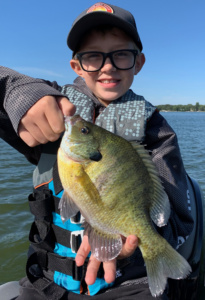Summer is winding down, but there’s lots of great open-water fishing still available. Baitfish have had months to grow and are more of a mouthful these days. Larger bluegills often look for a larger meal to fill their appetite. Small crankbaits and vertical jigging minnow baits can help you target some of the largest ’gills in the school. Larger baits often will intimidate smaller fish and keep most of them off the hook.

JPT member, Parker Revermann, son of Head Coach, Jason Revermann, caught and released this 10 1/8-inch bluegill while trolling a perch-colored No. 3 Original Floating Rapala behind a bottom-bouncer.
First, locate the fish. Usually you can find them around the outside edges of the weeds anywhere from 4 to 24 feet of water. That’s why you need to use your sonar units to locate marks off the bottom. Side scan really can shine when searching for ’gills, especially in shallower water. Adjust your side scan to get the best possible image when searching in shallower water. I like to set the width away from the boat to about four times the depth of water I am working.
 When schools of ’gills concentrate, you can vertically jig small jigging minnow baits like Jigging Raps or Ultralight Rippin’ Raps to catch some of the bigger individuals.
When schools of ’gills concentrate, you can vertically jig small jigging minnow baits like Jigging Raps or Ultralight Rippin’ Raps to catch some of the bigger individuals.
Often bluegills will scatter along the outside weed edge or along certain break lines. This is the perfect time to employ a trolling technique to cover more water and pick off the most aggressive fish.
I like to use a 1 1/2-ounce bottom bouncer with a 6-foot leader and a No. 3 Original Floater Rapala trolled 1 mile per hour or less. Something that makes this method extremely effective is to drop back the rod tip setting the weight on the bottom allowing the bait to pause and raise, then pull forward and to make the bait vibrate and dive. This pause-and-pull method triggers more bites than a constant trolling speed.
Make sure you are marking fish, and if they are not active move on and find more active fish.
Don't forget to practice selective harvest. It is great to be able to catch big panfish and to ensure there are big fish to catch in the future it is important to release the biggest fish to pass on their genes. Keep a few mid-sized fish for a meal but don't keep more than you plan to eat.
Good luck fishing and stay safe.


